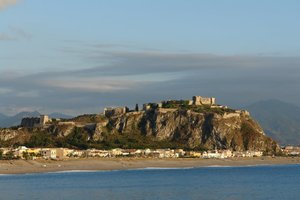
Produced in the north-eastern part of Sicily, the Mamertino DOC is also known as the “Emperor’s Wine”, because Julius Caesar used to drink it. The name originates from the Mamertini people, originally from Campania, who settled in the province of Messina in about 310 BC. In turn, their name was derived from Mamers, an ancient fertility god later adopted by the Romans as Mars, the god of war.
DOC wines produced here include Mamertino di Milazzo (both red and white wines), the red Mamertino Nero d’Avola and the white Mamertino Grillo-Ansonica. You can enjoy these and other local foodie delights along the following panoramic itineraries:
VALDINA – TORREGROTTA: Visit Valdina’s town center and its Norman Castle. In the nearby village of Tracoccia you can learn about the miraculous water of the 16th century Madonna dell’Acqua Santa Church. Admire the 17th century tapestry in San Paolino Church and what remains of the ancient Tower of Castrum in the town of Torregrotta. In this area you can enjoy not only wine tasting, but also try nettle and lemon grappa and unique types of brandies made from pears, apples, cherries and peaches from Mount Etna!
S. LUCIA DEL MELA – S. FILIPPO DEL MELA – MILAZZO: S.Lucia del Mela features the Arabian-Swabian-Aragonese Castle and a huge artistic heritage that includes the marmoreal group of the Last Supper by Valerio Villareale; the Ethnographic and Holy Arts Museum; and the S. Maria Church with a priceless painting by Caravaggio. Milazzo features its own Arabian-Norman Castle, an archaeological museum and even a wild, panoramic trail that reaches the rocky Sanctuary of S. Antonio from Padua and Faro. Local foodie delights include traditional nougat, martorana fruit, shellfish specialties and Valdemone DOP extra virgin olive oil.
Along these delicious and entertaining paths you can enhance the authentic local experience by staying in unique Sicilian properties. We have selected two that are off the beaten path:
Castello di Oliveri, Tindari – this beautiful, historic castle has Arab origins dating as far back as the end of the X century, when a tower was built for protecting the coast against the Normans. Throughout the centuries, the castle was owned by different people and appeared in various maps and texts, even in the work of Charles Alexis de Tocqueville. It is surrounded by a large park with century-old trees, exotic palms and even rare plants.
Agriturismo Fontanelle, San Filippo del Mela – this amazing, hidden estate features an organic farm that produces a variety of bio-food including vegetables, fruits, selected DOP Valdemone extra virgin olive oil, and even red and white wines. The estate includes old barns from the 1880s that have been renovated into an ‘agriturismo’ rustic house and a restaurant that serves traditional Sicilian cuisine prepared with organic products.
Photo credits:
Milazzo, photo by Michaliszyn
Tindari, photo by Bernardi
Castello Oliveri, photo by Natale Giunta
Agriturismo Fontanelle, Sicily